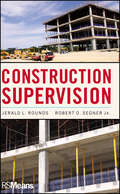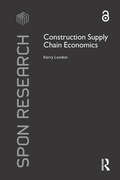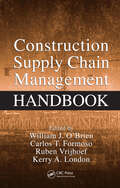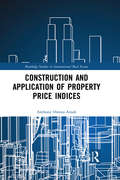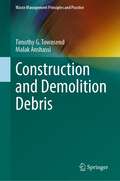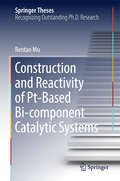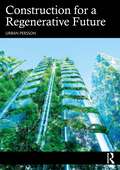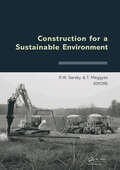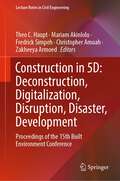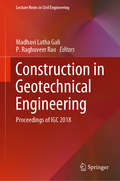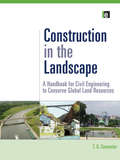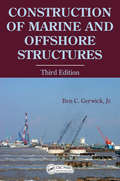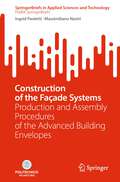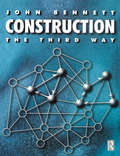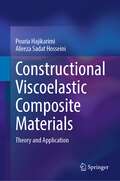- Table View
- List View
Construction Supervision
by Jerald L. Rounds Robert O. SegnerThis book covers all supervisory situations one is likely to encounter on a commercial, industrial, or institutional construction project. The book is based upon a very successful Electrical Project Supervision (EPS) training program developed by Rounds and Segner for the National Electrical Contractor?s Association and licensed to several organizations representing other construction sectors. This program has been delivered for over a decade and continues to be delivered to thousands of construction supervisors each year. The program content has consistently received outstanding reviews and evaluations in numerous different venues.
Construction Supply Chain Economics (Spon Research)
by Kerry LondonThis is the first comprehensive investigation of the industrial sourcing and procurement practices throughout sixty-eight construction industry supply channels across seven major commodity sectors at all levels. London presents real-world case studies to combine theory and practice to describe the economic structural and behavioural characteristics of sectors integral to the construction industry performance. Construction Supply Chain Economics details 'everyday' experiences and procurement decisions made by people in firms in the industry related to projects as they seek out other firms to work with during the tendering stage. London creates a language that enables us to classify and understand behaviour and recognise the impact of our decisions on firms and projects within the industry. Construction Supply Chain Economics introduces a new model for mapping the construction sector of particular interest to construction management and economic researchers and to procurement decision makers, including policymakers and clients, as well as industry practitioners, such as contractors, consultants and materials suppliers.
Construction Supply Chain Management Handbook
by William J. O’Brien Carlos T. Formoso Ruben Vrijhoef Kerry A. LondonMounting emphasis on construction supply chain management (CSCM) is due to both global sourcing of materials and a shortage of labor. These factors force increasing amounts of value-added work to be conducted off-site deep in the supply chain. Construction Supply Chain Management Handbook compiles in one comprehensive source an overview of the dive
Construction Technology 1: House Construction
by Mike Riley Alison CotgraveConstruction Technology 1: House Construction offers a highly accessible introduction to the key stages of domestic house construction from planning to internal finishes. Its student-friendly layout uses detailed figures, photos and case studies from real-life building sites to aid a practical understanding of construction techniques, providing clear step-by-step guidance in learning the basic principles of low-rise residential construction. This textbook is a vital resource for students in construction, property and architecture, BSc and MSc, including any student taking courses in building surveying, quantity surveying, real estate and construction management, as well as those studying at the HNC/HND level.
Construction Technology of Large Diameter Underwater Shield Tunnel (Key Technologies for Tunnel Construction under Complex Geological and Environmental Conditions)
by Jian Chen Fanlu Min Shouhui WangThis book systematically introduces the new technology used in the construction of underwater large slurry shields under complex conditions. The basic principles, scope of application, construction technology and technical points of the key technologies such as the origin and arrival of the shield, crossing the shallow soil in the middle of the river, crossing the guard, and changing the knife and opening the knife are clarified.
Construction Zones
by CaterpillarWhere do trucks and tractors work all day?From quarries to mines, from the snow to beneath the ground, trucks and tractors work in all kinds of construction sites. Get an up-close look at the important work they do!
Construction and Application of Property Price Indices (Routledge Studies in International Real Estate)
by Anthony Owusu-AnsahThe importance of house prices to households, real estate developers, banks and policy-makers cannot be overemphasised. House price changes affect consumer spending and business investment patterns, which in turn affect the wider macro economy and the entire business cycle. Measuring and understanding house prices is therefore essential to a functioning economy, but researchers continue to disagree on the best methodological approach for constructing real estate indices. This book argues the need for more accurate house price indices, outlines the various methods used to construct indices and discusses the existing house price indices around the globe. It shows how the raw data of property transactions can be prepared for the purpose of constructing indices, discusses various applications of property price indices and empirically demonstrates how the index numbers can be used to model the supply of new houses and to estimate the price elasticity of supply. Essential reading for economists, real estate professionals and researchers, and policy-makers.
Construction and Building Automation: From Concepts to Implementation
by Benny RaphaelThis book is intended to be used as a textbook in undergraduate civil engineering and construction courses to introduce cutting edge mechanical, electrical, and computer science topics that are needed for civil and construction engineers to collaborate in inter-disciplinary automation projects. Part I introduces the basics of hardware and software technologies that are needed for implementing automation in buildings and construction. The content begins with the fundamental concepts and uses practical examples to bring out the benefits of automation through case studies that are easy to understand. No other book uniformly treats the subject of automation within the context of buildings and construction activities. While the technology needed for these two application domains are similar, the unifying principles are not well recognized. This book will bring out the fundamental principles that could form the basis of application to these two domains. For example, it will become clear that sensors, actuators, and controllers, along with smart control strategies could be used for automating tasks within buildings and on construction sites. Part II of the book will introduce key advances in the areas of machine learning and artificial intelligence that are significant for the intelligent control of buildings and construction equipment. Control algorithms and techniques for data analytics are explained in a form that is appropriate for non-computer science students. Each chapter contains several hands-on exercises meant to apply the principles that are covered. These include numerical problems as well as design and analysis examples. This new textbook: • Introduces hardware and software needed for automating engineering tasks • Presents examples of applications in the control of building systems • Illustrates of the use of automation for improving construction processes • Provides a lucid introduction to advanced computing concepts, machine learning, artificial intelligence, and control algorithms to construction and engineering students. It is sure to be essential reading for a growing number of courses in smart construction, building automation, robotics, intelligent buildings, and construction 4.0. Supplementary material including answers to exercises in the book will be provided on the author’s website: https://bennyraphael.com/book2022/
Construction and Demolition Debris (Waste Management Principles and Practice)
by Timothy G. Townsend Malak AnshassiThis book addresses one of the major solid waste streams resulting from modern society, construction and demolition debris (CDD). CDD in the past has not received the same attention as other waste streams (e.g., municipal solid waste), but with the growing recognition of the environmental and economic importance of proper CDD management, this material now is the focus of attention of many government agencies and private businesses. This book provides a comprehensive review of CDD, its characteristics, environmental risks, and regulatory requirements, along with an in-depth discussion of the issues pertaining to CDD recycling and disposal.
Construction and Reactivity of Pt-Based Bi-component Catalytic Systems (Springer Theses)
by Rentao MuIn this thesis, the author outlines the construction of active structure and modulation of catalytic reactivity of Pt-based bi-component catalysts, from the model systems to real supported catalysts. The thesis investigates the promotion effect of the second components on catalytic performance of Pt catalysts, and presents the reversible generation of the "sandwich-like" structure of Pt-Ni catalysts, containing both surface NiO1-X and subsurface Ni by alternating redox treatments at medium temperature. With the aid of single layer graphene, the dynamic process of chemical reactions occurring on the Pt(111) surface can be visualized using in-situ LEEM and DUV-PEEM techniques, the results of which are included here. The author reveals that the graphene layer exhibits a strong confinement effect on the chemistry of molecules underneath and the intercalated CO can desorb from the Pt surface around room temperature and in UHV, which may promote the CO oxidation confined under graphene.
Construction for Interior Designers
by Roland AshcroftConstruction for Interior Designers is a highly readable, comprehensive and informative text proving all the technical information required. The second edition has been fully updated to reflect the 1991 amendments if the 1985 Building Regulations and includes a new chapter on environmental issues affecting construction. Important concepts are explained from first principles with three-dimensional diagrams and informative tables. No previous knowledge of the subject is assumed.
Construction for a Regenerative Future
by Urban PerssonThis is a book about how to manage the processes involved in a construction project towards a sustainable and regenerative endproduct. It covers key project management concepts and links the construction process to the objectives of UN SDGs and beyond zero carbon emissions throughout the whole project life cycle. This introductory textbook is written from a project manager's perspective including considerations of circular economy throughout the construction process focusing on a regenerative or restorative outcome. The book examines the importance of the type and purpose of a building, circularity and de-construction, the site, the client and its organisation, stakeholder considerations, the project organisation, the procurement of consultants and contractors, project performance during design and construction, project hand-over to the client, and the building's operation and maintenance. It also illustrates how to verify the building using existing environmental certifications, how to calculate carbon emissions, and how to deal with used construction materials from a circular economy perspective. International examples of best practice are included throughout, and the book is structured in a way which students will find engaging and easy to follow. This is an ideal textbook for use on construction, architecture, and engineering programmes where the emphasis must urgently be placed on students fostering regenerative construction solutions in their coming professional life.
Construction for a Sustainable Environment
by R. W. Sarsby T. MeggyesThe past fifty years have seen rapid development of public and governmental awareness of environmental issues. Engineers and scientists have made tangible contributions to environmental protection. However, further theoretical and practical developments are necessary to address mankinds growing demands on the environment. Construction for a Sustai
Construction in 5D: Proceedings of the 15th Built Environment Conference (Lecture Notes in Civil Engineering #245)
by Theo C. Haupt Mariam Akinlolu Fredrick Simpeh Christopher Amoah Zakheeya ArmoedThis book gathers the latest advances, innovations, and applications in built environment, as presented by international researchers at the 15th Built Environment Conference, held in Durban, South Africa, on September 27-28, 2021, and organized by the Association of Schools of Construction of Southern Africa (ASOCSA). The overarching theme of the conference was “Construction in 5D: Deconstruction, Digitalization, Disruption, Disaster, Development”, with contributions focusing on current trends, innovations, opportunities and challenges, policies and procedures, legislation and regulations, practices and case studies, in both the public and private sectors. The volume will contribute to the existing body of knowledge relative to the science and practice of construction not only in South Africa but wherever the products of construction are produced even in these new challenging times of fear and uncertainty.
Construction in Cities: Social, Environmental, Political, and Economic Concerns
by Patricia J. LancasterToday's construction environment is more complex than any previous era. The possible impediments to a project's successful completion include not only "bricks and mortar" issues like material availability or curtain wall testing, but a broad array of concerns involving the economic, political, social, environmental, archeological, community, and hi
Construction in Geotechnical Engineering: Proceedings of IGC 2018 (Lecture Notes in Civil Engineering #84)
by Madhavi Latha Gali P. Raghuveer RaoThis volume comprises select papers presented during the Indian Geotechnical Conference 2018. This volume discusses construction challenges and issues in geotechnical engineering. The contents cover foundation design and analysis, issues related to geotechnical structures, including dams, retaining walls, embankments and pavements, and rock mechanics and construction in rocks and rocky environments. Many of the papers discuss live case studies related to important geotechnical engineering projects worldwide, providing useful insights into the realistic designs and constructions. This volume will be of interest to students, researchers and practitioners alike.
Construction in the Landscape: A Handbook for Civil Engineering to Conserve Global Land Resources
by Carpenter T.G.Construction in the Landscape describes the impact of construction on the land and landscape where it takes place. Geographical coverage is necessarily global to reflect the great variation both in people‘s economic and social needs and in the shortage or abundance of natural resources. Part I introduces both land resources, whether used for agriculture, human settlement or mineral extraction or conserved as scenery, wildlife habitat or for the undefined needs of future generations; and construction, its products, skills, processes and impacts on land resources. Part II describes specific forms of civil engineering - from landform adaptation, through dams and river control works, coastal construction and transport infrastructure to particular types of structure such as bridges, towers and power stations, or the layout of complete settlements. Part III deals with regional planning of construction and land use in different geographical circumstances - from fine scenery, through rural countryside to city and suburban development - and to the sort of land arrangements that may be sustainable for an increased but hopefully more civilized human population a century hence.
Construction of Buildings on Expansive Soils
by E.A. SorochanThe series comprises selected translations of Russian geotechnical literature, and this is a translation of a 1989 second edition reference. Coverage includes laws governing expansion and contraction of argillaceous soils, principles governing deformation of soil mass and foundations during soil exp
Construction of Marine and Offshore Structures
by Ben C. Gerwick Jr.For two decades, Ben Gerwick's ability to capture the current state of practice and present it in a straightforward, easily digestible manner has made Construction of Marine and Offshore Structures the reference of choice for modern civil and maritime construction engineers. The third edition of this perennial bestseller continues to be the most mo
Construction of the Façade Systems: Production and Assembly Procedures of the Advanced Building Envelopes (SpringerBriefs in Applied Sciences and Technology)
by Ingrid Paoletti Massimiliano NastriThe book explores the advanced façade systems according to the productive and constructive contents, in a cognitive and operative form, as a manual text to provide guidelines for researchers, technicians and professionals. It provides operational guidance for the technological design, production planning and site executive coordination for the realization of façade systems. The analysis deals with the main building elements and technical interfaces. The study of the façade systems, after explaining the anchoring structures and their connections to the load-bearing elements, investigates the criteria for the assembly between the framings. In particular, the book examines the technical interfaces of the main advanced envelope systems with respect to the functional, constructive and applicative coordination procedures of the mullions and transoms framing, of the structural sealant glazing façade system, of the unit façade system, of the suspended façade system and of the double skin façade system. The technical and manual character of the book is also expressed through the analysis of the functional and application procedures of the gaskets with respect to the façade systems in order to prevent the transmission of air and water loads: the analysis focuses on the connections between the framing and the enclosure elements of the envelope, in accordance with the compensation of height differences in order to guarantee impermeability, airtightness and insulation. Then, the book describes the assembly and interface conditions between elements of different composition and production within the façade systems: the examination of the technical interfaces involves the development and application of sealants, based on the loads exerted on the jointing devices, in order to fulfill the requirements of sealing and tightness with respect to mechanical, thermal and hygrometric, water, air and wind stresses. Moreover, the study of the envelope systems examines the methodologies directed toward fulfilling the requirements with respect to the actions caused by fire loads, considering the contents related to both components and connections and fixing surfaces.
Construction the Third Way
by John BennettThis book describes current best practice in managing construction. It is based on case studies of leading practice responding to demands from customers that construction match the value and quality that international competition is forcing on their own businesses. The case studies show that major customers now partner with construction firms to find more efficient ways of working. The resulting best practice adds to these cooperative approaches a drive for efficiency and innovation based on benchmarks of world class performance that empower teams to set themselves competitive targets. So the new approach balances cooperation and competition.This is why Professor John Bennett's book is called ''Construction: The Third Way.'' The third way in modern politics balances the extremes of cooperation and competition in the interests of the whole community. At its best it encourages sustainable economic growth within a fair society. These aims are echoed in leading practice where teams able to balance cooperation and competition deliver better value for their customers and yet earn sustainably higher profits for construction.The new approach requires managers to rethink construction using ideas from fundamental science that see human organizations as self-organizing networks of relationships. This throws new light on the strengths and weaknesses of both competition and cooperation, and provides the basis for a new paradigm to guide key construction decisions. The book describes this background and provides advice about organization structures that are responsive to changing markets and technologies, and construction processes that enable the industry to earch fair profits by providing customers with the levels of value and quality they now demand.
Construction, Demolition and Disaster Waste Management: An Integrated and Sustainable Approach
by Erik K. LauritzenConstruction and Demolition Waste (CDW), from the construction, maintenance, renovation and demolition of buildings and structures, represents a large proportion of the waste in industrialized societies. Compared to other forms, such as household waste, more than 90% of CDW can be used as a resource and a substitute for construction materials, especially for primary, natural raw materials. Reuse, recovery and recycling depends on the quality and market for the materials, and the environmental impact of the processes for conversion of CDW from old structures to its use in new structures. However, the utilization today of CDW products as secondary resources is marginal. Most CDW is deposited or used as fill material, and the opportunities of high quality recycling are generally neglected. This book presents the opportunities for the sustainable and resource efficient utilisation of CDW, focusing on recycling of concrete and masonry as the major forms of CDW. The recycling of gypsum, timber, mineral wool, asphalt and other types are also described. Its aim is to present a chain of value and material streams in the transformation of obsolete buildings and structures into new buildings and structures. It takes a holistic view, focusing on the lifecycle economy (the circular economy) and integrated management aspects of various scenarios ranging from high industrial urban renewal to debris removal and management after disasters and conflicts. It is based on the author´s 35 years of research and development combined with practical international experience within the demolition and recycling area. It addresses students, architects, civil engineers, building owners, public authorities and others working in urban planning, demolition and resource management in the building and construction sector and in the reconstruction of damaged buildings after disasters and wars.
Constructional Engineering and Ecological Environment: Proceedings of the 4th International Symposium on Architecture Research Frontiers and Ecological Environment (ARFEE 2022), Guilin, China, 23-25 December 2022
by Chih-Huang WengConstructional Engineering and Ecological Environment contains papers presented at the 4th International Symposium on Architecture Research Frontiers and Ecological Environment (ARFEE 2022, Guilin, China, 23–25 December, 2022). With a focus on hot research topics and difficulties in construction technology and ecological environment, this book provides the latest research results on a variety of topics: building structure civil engineering seismic technology ecological environment repair The book is aimed at engineers, scholars and researchers in construction, structural engineering and environmental sciences.
Constructional Steel Design: World developments
by R. Bjorhovde P. J. Dowling J. E. Harding E. Martinez-RomeroThis book consists of the papers presented at the First World Conference on Constructional Steel Design held in Acapulco, Mexico, December 1992. The Conference provided a forum for presentation and discussion by designers and research workers involved with steel construction.
Constructional Viscoelastic Composite Materials: Theory and Application
by Pouria Hajikarimi Alireza Sadat HosseiniViscoelasticity is a complicated theorem that is generally used in several aspects of material characterization and modeling of polymers, resins, fiber-reinforced composites, bituminous composites, etc. On the other hand, the heterogeneous nature of composites like asphalt concrete and fiber-reinforced polymers has motivated lots of researchers to investigate the mechanical and rheological properties of these materials. This book mainly consists of the theory and application of viscoelastic materials used for construction. It starts with a comprehensible presentation of the theory of linear and nonlinear viscoelasticity. Wherein, the application of viscoelastic equations and principles on constructional viscoelastic composite materials considering time, temperature, loading rate dependency, and heterogeneity of composite substances is highlighted. The principles and equations of the viscoelasticity theorem are presented in several books, but here it is tried to present them more understandable and straightforwardly. This helps in solving real problems of heterogeneous composite materials, especially those which are used in construction. Moreover, the fundamental experiments for characterizing the elastic and viscoelastic properties of fibrous and bituminous composites are introduced and summarized. Then after, some analytical and empirical formulations for deriving the material properties of composites from the properties of the basic constituents are presented. These are followed by numerical simulation techniques using the finite element method to simulate composite materials.
